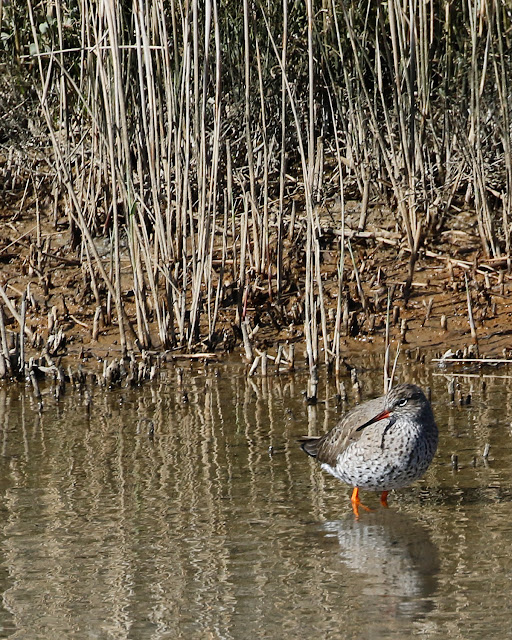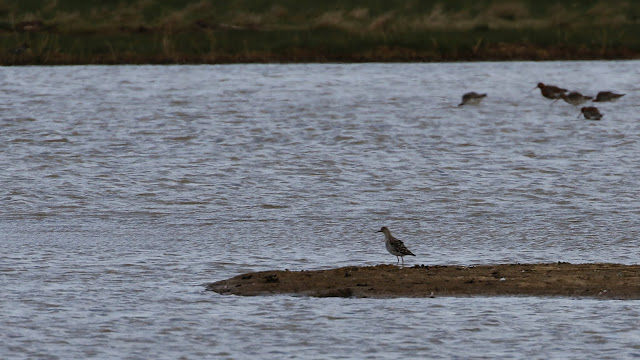The forecast was for cloud to move in during the early afternoon, so I decided to pull over and take some photographs of the mill against the blue sky.
Our destination was to be Cley Marshes, probably the most famous nature reserve in the UK. The Cley Marshes reserve was created in 1926 when Norfolk birdwatcher Dr Sydney Long bought the land which now makes up the reserve for the sum of £5,100, to be held "in perpetuity as a bird breeding sanctuary". Long then established the Norfolk Wildlife Trust.
We arrived at the new visitor centre which is a very impressive site, checked in and then set off along the path that runs parallel with the A149. On the other side of the path is the reedbed.
To say there was not much of interest was probably an under statement. The wind was fresh and everything seemed to be sheltering from the wind, probably a shock after yesterday's warm conditions. In the sunshine the bottle green of the drake Mallard's head was standing out.
At the end of the east wall there was a sheltered hide and we stopped to take shelter from the wind for awhile. Looking out into the pool close by was the now expected Avocet, again sheltering from the wind, and close by a Redshank.
On the other side of the pool there was a Redshank, the clear water reflecting the bird.
It was becoming clear that we, or I had made a mistake, the walk along the east wall had not produced much, and it was either a walk back the way we had come to get to the hides, or a trek along the beach. Foolishly I opted for the beach, probably in the hope of something moving along the coast. It never did! The pebbles mad walking very difficult, and this coupled with the fact that this route was far longer did not add to the atmosphere. Finally we reached the beach road, and walked along the footpath to the main road. At the junction there was a lovely view of the Cley Windmill and the church. The churches towers can always be seen from a distance, and are either a square based tower, or sometimes round.
We followed the reserve path, and turned into the marsh towards the hides in the middle. A group of three hides were available to us, and we tried all three, finally deciding the central hide was probably the best. Looking out on the scrapes there was little about. The most numerous bird was the Avocet once again, and pairs could be seen almost all over the scrapes. At the visitor centre the count was of 97.
The Avocet were not just feeding, there was also some mating going on. They have a little display that ends in copulation and a sprint through the water, but I only managed to get the mounting.
We spent time scanning the water and islands, there was still quite a fresh breeze, that must have been a shock after yesterday's warmth. Many of the birds were sheltering like this Lapwing that was also a little shy.
A distant wader looked of interest, and fortunately it came closer to one of the islands. It was a Ruff, and it looks like a male on the way to its flamboyant breeding plumage.
The hide had several visitors now, and with all the windows open a Greylag Goose, that was standing guard while its mate fed on the bank, seemed to ne very concerned by us and started into the hide.
The Ruff then came even closer, and confirmed that it was a male bird.
With all the Avocet paired up it would seem that the pairs had also determined their territories.
Should any other pair come to close it would result in a confrontation where both would approach the other pair, with the heads bowed and bill pointed down.
Then both birds would rush the other two in an attempt to push them away and out of the area.
A blizzard of white and black as they jumped and flapped their wings.
Once the pair was gone calm returned and the pairs would go about feeding together.
Now I have visited Cley many times over the years, and it always seems the same to me. Far to big, with little in the way of consistent birds to keep you happy. I have to compare it to Minsmere where there is always something to see. So we decided that we needed a coffee, and then we would head back to Titchwell where there was definitely more of interest on Saturday, and it would probably be so today.
The journey took around 40 minutes, and we pulled into the car park once again with Blackcaps singing. From the car park we headed out along the sea wall once again, and alongside the wall in the freshwater marsh was the pair of Red-crested Pochards, the drake still parading its golden wig.
Rather than a walk to the beach we headed for the parrinder Hide and the freshwater. The light wasn't too bad, and as we sat down I found a Ruff feeding on the mud quite close to the hide.
Then Helen found one of the birds I had been hoping for, a Little Ringed Plover. Although a little bit away from the hide the yellow eye ring was clearly visible.
As it fed around the small pools it came closer. There were in fact three Little Ringed Plovers around the muddy pools.
Right underneath the hide window were dabbling Teal, and Gadwall, there was also two male Shovelers,and a female. In those circumstances something was always going to happen. One of the drakes started to display, stretching it's head up and down and waving it's large bill skywards.
This seemed to aggravate the other male, who was probably the females chosen mate, and he rushed at the other duck.
It was then the aggressor that took on the displaying, while the other just played it cool.
When the Shoveler does display it changes the look of the duck.
As was to be expected there were lots of Avocets about, and with the light making the water very bright there were some lovely reflections in the shallow water as the Avocet fed.
The paired birds would feed almost in perfect symmetry.
It was then the turn of the Gadwall to get aggressive, again due to the fact that there were more males than females about. This male came to close to a pair.
And he was quickly told that he was not welcome, and chased away.
It was then back to the Avocets and more lovely reflections.
There was also more fighting and posing from the pairs, these two pairs just squared up before one pair backed away.
The Ruff came close again, a male bird too.
A lot of Brent Geese were on the water, and they gradually became noisier and noisier, which is usually a sign that they will leave, and sure enough they took off in groups away over the hide.
We decided to go and get a coffee at the cafe, and as we walked along the sea wall, the first Marsh Harrier of the day flew over the distant reeds. After our coffee we walked out on the east trail, stopping at the the Fen Hide to watch another male Marsh Harrier that appeared above us.
It came low over us, giving the best views so far.
In the horse paddock adjacent to the reserve was a single Egyptian Goose.
The pool was covered in Gadwall once again and Greylag geese, but nothing else. At the end of the trail we heard a Bittern booming and stopped for awhile in the hope that it might appear. All we did see was more Marsh Harriers in the distance, and Greylag Geese impersonating Bitterns. As we made our way back to centre of the reserve we could still hear the Bittern.
So it was back along the seawall where we stopped to listen to Reed Warblers singing. This must have arrived in the last two days as there were none singing here on Saturday. We had very brief glimpses of the warblers, and we stood listening to the Reed Warblers, Cetti's Warblers and the pings of Bearded Tits. The only one of those three to show for a suitable amount of time was the Cetti's Warbler.
Nice to be able to see the owner of the explosive song.
Below us once again was the Red crested Pochard, I couldn't resist it.
We went back to the hide, in the hope of something, but became taken in by the antics of the Avocets. This pair were quite happy with both heads tucked under the wing until one woke up.
The bird on the left here was the female, and soon after waking she adopted here mating position with the head extended low on the water. The male then comes alongside her and starts to preen.
He continues to preen, moving from side to side of her, always from behind.
After what seemed a long time but was probably minutes he stops preening and starts to nibble the back of her neck.
He then mounts her, the female continuing to lay horizontally on the water.
He balances on her using his wings to hold him up, then slides back to get into a position to complete the act.
On consumatingthe act both birds then come alongside each other and rush away across the water.
Finishing with both birds tapping their bills.
After that it was back to the synchronised feeding.
I have seen this behaviour many times, and have been able to record it previously, but never in this detail, or so close, it is lovely to watch.
Away from the Avocets a small wader, a Dunlin, fed on the edge of the mud in front of the hide.
Black-tailed Godwits have been around the marsh, but these three were quite close for once, and the bird on the left is almost in the beautiful brick red breeding plumage.
Time was getting on, and we had to leave, our time in Norfolk was coming to an end. But as we walked down the sea wall past the Island hide, we heard the pings of a Bearded Tit once again. We just had to stop, and I am glad we did. Finally a male appeared amongst the reeds.
Then even clearer at the top just under the seed heads.
And sat there, checking all around it.
Then dropped down into the reeds but appeared again, this time showing off its acrobatic abilities. Not the sharpest shot but shows the posture.
Then gone again, but this time when it came back it was much closer.
Saving the best for last...
Then away, dropping into the reeds and a shot that is probably what is seen of this spectacular bird the majority of the time.
And so a day that started rather badly saved the best for last. Some wonderful Avocet behaviour, and of course the Bearded Tit at the very end.
It was a lovely weekend made perfect by the amazing weather. Who would have though that as well as coming back with a lot of wonderful photographs I we would also bring back the start of this year's sun tan.






















































No comments:
Post a Comment